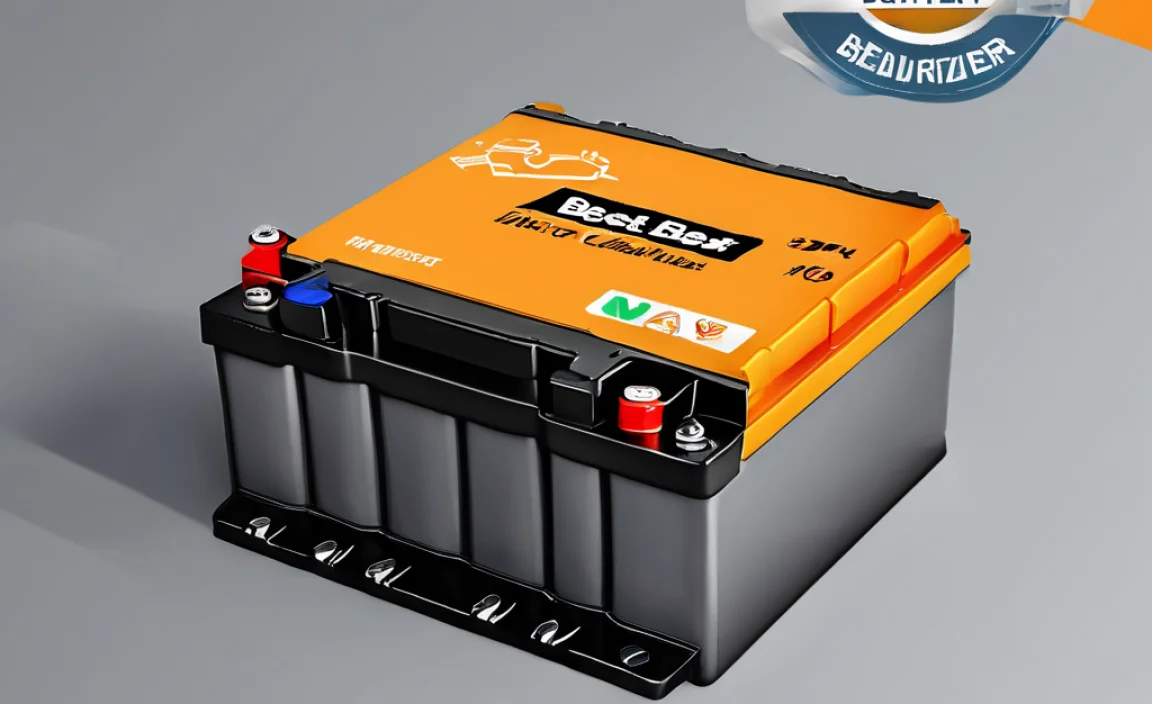Mr Heater adapter for propane tank: Essential Guide
Connecting your Mr Heater to different propane tanks is easy with the right adapter. This guide shows you the common types, how to choose the best one for your needs, and simple steps to ensure a safe and secure connection every time. Get your heater running smoothly without the hassle!
—
Are you trying to hook up your Mr Heater for a cozy evening or an important project, only to find your propane tank and heater don’t quite match up? It’s a common puzzle, but thankfully, there’s a simple solution: a propane tank adapter. These little connectors act as bridges, making sure your heater can safely and efficiently draw fuel from various propane tanks.
Think of it like needing the right plug for an electrical outlet. Without the correct adapter, your appliance just won’t work. This guide is here to demystify the world of Mr Heater adapters for propane tanks. We’ll walk you through what you need to know, from identifying the different types of connections to making a secure fit. No confusing tech talk, just straightforward advice to get you powered up safely and confidently.
—
Understanding Propane Tank and Heater Connections
Before we dive into the adapters, it’s helpful to know what you’re working with. Propane tanks and propane-powered appliances, like Mr Heater units, have specific fittings. These fittings are designed for safety and to prevent the wrong size tank from being connected to an appliance.
Common Propane Tank Fittings
The most common propane tanks you’ll encounter are:
5 lb or 1 lb Disposable Propane Cylinders: These are small, often green cylinders. They typically have a standard POL (Prest-O-Lite) connection or a 1-inch x 20 male throwaway cylinder thread. These are great for portable heaters and offer convenience.
20 lb Propane Tanks (Grill Tanks): These are the most common tanks for home use, often seen with BBQ grills. They usually have a Type 1 (also known as a QCC-1) connection, which is a self-sealing connection that shuts off gas flow when not connected to an appliance.
Larger Propane Tanks (like those for RVs or homes): These can have various fittings, but for connecting portable Mr Heaters, the most relevant are the larger cylinders that might also use a POL fitting or a robust QCC-1 type connection.
Common Mr Heater Connections
Mr Heater portable propane heaters are designed with versatility in mind, but they often come with a specific type of inlet fitting. Many have a regulator with a POL fitting designed for older or 1 lb disposable cylinders. However, newer models or specific heater types might come with a diverter or regulator that has a Type 1 (QCC-1) connection for use with standard 20 lb grill tanks.
The mismatch often occurs when you have a heater designed for a POL fitting and want to use a common 20 lb grill tank, or if you have a heater meant for a 20 lb tank and want to use a smaller disposable cylinder. This is where the adapter becomes your best friend.
—
Why You Might Need a Mr Heater Adapter for Propane Tank
The primary reason for needing an adapter is compatibility. The threaded connections on propane tanks and appliances aren’t universal. For instance, a regulator on a Mr Heater unit might be set up to screw directly onto a 1 lb disposable cylinder. If you want to use that same heater with a larger 20 lb tank, you’ll likely need an adapter to bridge the gap between the heater’s regulator connection and the 20 lb tank’s Type 1 connection.
Here are some common scenarios where an adapter is essential:
Connecting a heater designed for disposable cylinders to a larger refillable tank: This is very common. Many portable heaters come with a regulator that screws directly onto 1 lb disposable tanks. To use a 20 lb tank, you’ll need an adapter to connect the heater’s regulator to the 20 lb tank’s Type 1 fitting.
Connecting a heater designed for larger tanks to smaller disposable cylinders: Less common, but if you have a Mr Heater with a regulator already set up for a Type 1 connection and want to use a 1 lb bottle, you’ll need an adapter for that.
Ensuring a secure and leak-free connection: While adapters are primarily for compatibility, using the correct, high-quality adapter also ensures a tight seal, which is crucial for safety when working with flammable gas.
—
Types of Mr Heater Adapters for Propane Tanks
Adapters come in various forms, each designed for specific tank and appliance connections. Understanding these will help you pick the right one.
Common Adapter Configurations
Familiarize yourself with these names and what they do:
1. POL to Type 1 (QCC-1) Adapter:
Purpose: This is perhaps the most frequently used adapter. It allows you to connect a propane appliance or regulator that has a POL tank connection (often found on older appliances, some dive tank setups, and regulators designed for 1 lb cylinders) to a standard 20 lb BBQ grill tank, which has a Type 1 (QCC-1) fitting.
How it works: The POL end screws onto the POL fitting on your regulator or appliance, and the Type 1 end screws onto the valve of the 20 lb propane tank.
Common Use: Connecting propane heaters, camp stoves, or other propane devices with POL regulators to a common 20 lb tank.
2. Type 1 (QCC-1) to POL Adapter:
Purpose: This adapter does the opposite of the POL to Type 1. It allows you to connect a device with a Type 1 connection (like a regulator originally designed for a 20 lb grill tank) to a propane tank that has a POL fitting.
How it works: The Type 1 end connects to your appliance’s regulator, and the POL end screws onto the POL tank valve.
Common Use: Less common for Mr Heaters but might be used if you have an older tank with a POL valve and an appliance regulator designed for newer QCC-1 tanks.
3. Throwaway Cylinder Adapter (1 lb to larger tank):
Purpose: These adapters are specifically designed to connect your Mr Heater (or other propane appliance) to a standard 20 lb or larger propane tank. They often bypass the small disposable cylinder regulator and connect directly to the appliance’s gas inlet.
How it works: One end connects to the propane appliance’s gas inlet (which might be a POL fitting or a specific hose connection), and the other end attaches to the Type 1 (QCC-1) valve of a 20 lb tank. Some are simply a hose with the correct fittings on each end.
Common Use: Using Mr Heaters that are designed to fit directly onto 1 lb cylinders, but wanting to use a large 20 lb tank for longer run times.
4. Hoses with Built-in Adapters:
Purpose: Some adapters are not standalone fittings but are integrated into a propane hose. These hoses will have a specific fitting on one end to connect to your Mr Heater’s regulator or gas inlet and a different fitting on the other end to connect to your propane tank.
How it works: You connect one end of the hose to your heater and the other end to your chosen propane tank. This is a convenient all-in-one solution.
Common Use: Connecting Mr Heaters that come with a short hose meant for disposable cylinders to a larger tank.
Key Features to Look For
When selecting an adapter, pay attention to these features to ensure safety and proper function:
Material: Look for brass construction. Brass is durable, corrosion-resistant, and ideal for propane fittings. Avoid adapters made of plastic or cheap metals.
Leak Check Valve: Some adapters have built-in leak-check valves, which is a good safety feature.
Gas Pressure Rating: Ensure the adapter is rated for the pressure and flow rate your Mr Heater requires. Most standard propane adapters are designed for low-pressure systems.
Certifications: Look for certifications such as UL (Underwriters Laboratories) or CSA (Canadian Standards Association) to ensure the product has been tested for safety.
Specific Heater Model Compatibility: While many adapters are universal for their connection types, it’s always a good idea to check if the adapter is recommended for your specific Mr Heater model or type of connection.
—
How to Choose the Right Mr Heater Adapter
Selecting the correct adapter depends entirely on the connections of your Mr Heater and the propane tank you intend to use. It’s a simple match-making process.
Step-by-Step Selection Guide
Follow these steps to find the perfect adapter:
1. Identify Your Mr Heater’s Connection:
Look at the regulator or gas inlet on your Mr Heater.
Does it have a fitting that screws directly onto a 1 lb disposable propane cylinder? This is usually a male thread designed for that cylinder. The part that screws onto the tank is often a POL fitting.
Does it have a fitting that screws onto a 20 lb tank’s Type 1 (QCC-1) connection? This is a female connection with a large nut that tightens onto the Type 1 tank valve.
Does it have a hose with a specific connection? Note the type of fitting at the end of the hose.
Tip: If unsure, locate the model number of your Mr Heater and search online for its specifications or a manual.
2. Identify Your Propane Tank’s Connection:
1 lb Disposable Cylinder: These have a standard male thread (1-inch x 20 TPI) and a small control knob.
20 lb Grill Tank: These have a Type 1 (QCC-1) connection. It’s a female fitting with a large nut that rotates to secure onto the tank valve, and it has an internal safety mechanism that shuts off gas if not properly connected.
Larger Tanks: These often use a POL fitting (a male thread that screws into a female tank valve, requiring a wrench to tighten) or a Type 1 (QCC-1) connection.
3. Match the Connections: Now, think about how to bridge the gap:
Scenario A: Mr Heater with POL regulator (for 1 lb cylinders) + 20 lb Tank: You need to connect your POL regulator to the Type 1 valve of the 20 lb tank. This requires a POL to Type 1 (QCC-1) Adapter. The POL end screws onto your regulator, and the Type 1 end attaches to the 20 lb tank.
Scenario B: Mr Heater with Hose/Regulator for 1 lb cylinders + 20 lb Tank: If your Mr Heater comes with a hose and regulator designed to screw onto a 1 lb cylinder, and you want to use a 20 lb tank, you’ll need an adapter that connects the other end of your Mr Heater’s hose to the 20 lb tank. This might be a specific “disposable cylinder adapter” or a hose designed for this purpose with a Type 1 fitting at one end and the correct fitting for your heater at the other.
Scenario C: Mr Heater with Type 1 regulator + 1 lb Cylinder: You need an adapter that connects your Type 1 regulator to the 1 lb cylinder’s male thread. This would be a Type 1 (QCC-1) to 1″-20 Male Throwaway Cylinder Adapter.
Scenario D: Mr Heater with Type 1 regulator + Larger Tank with POL fitting: You need an adapter to connect your Type 1 regulator to the POL valve. This is a Type 1 (QCC-1) to POL Adapter.
4. Consider the Inline Regulator:
If your Mr Heater comes with its own regulator (which is very common), the adapter typically connects to the output side of that regulator. Most Mr Heaters designed for disposable cylinders have a POL fitting on their regulator. You are then adapting that POL fitting to connect to your larger tank. If your Mr Heater doesn’t have an integrated regulator for propane flow control, you might need to purchase one separately and then use an adapter to connect it to the tank. However, most portable heaters include this vital safety component.
Example: The Most Common Setup
Let’s say you have a classic Mr Heater Buddy, which typically comes with a regulator that screws directly onto small 1 lb disposable propane cylinders. You want to use it with a 20 lb propane tank you already have for your grill.
Mr Heater Connection: POL fitting (on its regulator).
Propane Tank Connection: Type 1 (QCC-1) valve.
Required Adapter: You need to connect the POL fitting of your Mr Heater’s regulator to the Type 1 valve of the 20 lb tank. The adapter you need is a POL to Type 1 (QCC-1) Adapter. This adapter will have a POL fitting on one side to screw onto your Mr Heater’s regulator and a Type 1 fitting on the other side to screw onto your 20 lb propane tank.
Resources for Propane Fittings Information
For more detailed information on propane fittings, you can refer to resources like:
National Propane Gas Association (NPGA): While they cater to industry professionals, their resources often explain standard fittings.
Manufacturer Websites: Mr Heater, Flame King, and other propane accessory manufacturers often have diagrams and information about their product connections.
Reputable Retailer Websites: Websites like Amazon, Home Depot, Lowe’s, and specialized propane equipment suppliers will often provide detailed descriptions and images of adapters, helping you identify what you need.
—
How to Safely Install Your Mr Heater Adapter
Safety is paramount when dealing with propane. Installing an adapter correctly ensures a leak-free connection and prevents potential hazards. Always follow these steps.
Tools You Might Need
Most connections can be made by hand, but a few tools can ensure a secure fit:
Adjustable Wrench or Propane Wrench: For POL fittings, which require tightening with a wrench. Type 1 connections are typically hand-tightened, but a wrench can sometimes help ensure a snug fit if needed.
Soapy Water Solution: Essential for leak testing.
Rag: To keep your hands clean and for drying.
Step-by-Step Installation Guide
Follow these instructions carefully for a safe and secure setup.
Step 1: Ensure Everything is Off and Disconnected
Make sure your Mr Heater is turned off.
If you’re connecting to a propane tank that already has a regulator or hose attached, disconnect everything.
Ensure the propane tank valve is closed.
Step 2: Inspect Your Adapter and Fittings
Examine the adapter and the receiving fitting on your Mr Heater and propane tank.
Look for any obvious damage, dirt, or debris. Clean them if necessary with a dry cloth. Damaged threads or debris can prevent a proper seal.
Step 3: Connect the Adapter to Your Mr Heater (if applicable)
If your adapter is designed to connect to the Mr Heater’s regulator first (e.g., a POL fitting on the adapter connects to a POL fitting on the regulator), carefully screw the adapter onto the heater’s connection.
For POL fittings (found on many Mr Heater regulators), align the threads and screw the adapter on. Once seated, use an adjustable wrench to tighten it an additional 1/4 to 1/2 turn. Do not overtighten, as this can damage the fitting.
For Type 1 fittings, hand-tighten the adapter onto the regulator until snug.
Step 4: Connect the Other End of the Adapter to the Propane Tank
Now, attach the other end of the adapter to your propane tank.
For 20 lb Tanks (Type 1 connection): Align the adapter’s Type 1 fitting with the tank valve. Ensure the wings on the adapter nut align with the tank valve. Hand-tighten the large nut clockwise until it’s snug. You’ll feel it seat firmly. These are designed to be hand-tightened for safety.
For POL connections on tanks: Align the adapter’s POL fitting with the tank valve and screw clockwise. Tighten with a wrench about 1/4 to 1/2 turn past hand-tight.
Step 5: Open the Propane Tank Valve Slowly
Once the adapter is securely connected to both the Mr Heater and the tank, slowly open the propane tank valve. Turn it counter-clockwise.
Listen and feel for any obvious leaks as the gas begins to fill the line.
Step 6: Perform a Leak Test (Crucial for Safety)
Mix a solution of dish soap and water. You can use a spray bottle, sponge, or brush.
Apply the soapy solution liberally to all connections: where the adapter connects to the Mr Heater regulator, and where the adapter connects to the propane tank.
Watch carefully for bubbles. If you see any bubbles forming, or if you hear a hissing sound, you have a leak.
If you detect a leak: Immediately close the propane tank valve. Disconnect the adapter. Inspect all fittings for damage or debris. Reconnect securely and repeat the leak test. If the leak persists, do not use the connection and seek a new adapter or professional assistance.
Step 7: Connect the Heater Hose (if applicable)
If your Mr Heater uses a separate hose, ensure that hose is securely attached to the Mr Heater’s gas inlet and the adapter (or the regulator if the adapter connects directly to the tank).
Perform a leak test on these connections as well.
Step 8: Attach the Mr Heater (if not already done)
Some adapters are simply fittings, and you’ll attach your Mr Heater’s regulator to the adapter. For others, the adapter *is



